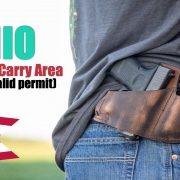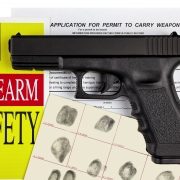Constitutional Carry in Ohio is legal but.. Only CCW Permit Holders who follow ORC Title 29.2923.122 are legally allowed to possess a firearm in a School Safety Zone.
The Law
Ohio Revised Code Title 29: 2923.122.
School Safety Zones (4) This section does not apply to a person who conveys or attempts to convey a handgun into, or possesses a handgun in, a school safety zone if at the time of that conveyance, attempted conveyance, or possession of the handgun all of the following apply:
(a) The person has been issued a concealed handgun license that is valid at the time of the conveyance, attempted conveyance, or possession or the person is an active duty member of the armed forces of the United States and is carrying a valid military identification card and documentation of successful completion of firearms training that meets or exceeds the training requirements described in division (G) (1) of section 2923.125 of the Revised Code .
(b) The person leaves the handgun in a motor vehicle.
(c) The handgun does not leave the motor vehicle.
(d) If the person exits the motor vehicle, the person locks the motor vehicle.
SB 215 2022
1. Understanding Criminal Charges for Illegal Conveyance or Possession of Deadly Weapon in an Ohio School Safety Zone
Ohio Code § 2923.122 criminalizes the “illegal conveyance or possession of a deadly weapon or dangerous ordnance in a school safety zone.” Specifically, it is illegal for any person to knowingly covey, attempt to convey, or possess a deadly weapon or deadly ordinance in a school safety zone. It is also illegal to possess and display or brandish an object that is indistinguishable from a firearm in a school safety zone in any way that indicates the object is a firearm. This means “an object made, constructed, or altered so that, to a reasonable person without specialized training in firearms, the object appears to be a firearm.” Firstly, it’s important to define what Ohio considers a “school safety zone” as it’s far from intuitive. Ohio Code § 2901.01 defines a school safety zone as a:
- School – Defined as any public school operated by the Board of Education, any school established by the local community, and any private school operating under the standards set by the Ohio Board of Education. This may include certain homeschooling
- School Building: Any building in which the instruction, extracurricular activities, or training provided by a school is conducted.
- School Premises: The entire parcel of property on which the school is located or any parcel of property owned or leased by a qualified school.
- School Activity: Any activity held with the support and authorization of a qualified school.
- School Bus: Any bus designed to carry more than nine passengers and owned or leased by a qualifying school authority to transport children to and from school or a school event. This does not include public busses or vans operated by daycares.
This means a school safety zone can include the local community center, pool, tennis courts, or off-premises location where school activities are held. Even areas open to the public, such as a track or playground next to a school, may be owned by the school itself and, as such, a school safety zone. Secondly, deadly weapons and dangerous ordnances include all firearms and handguns, including unloaded or even certain disassembled firearms, any military-grade weaponry, chemicals and explosives, mufflers, makeshift bombs, ballistic knives, or any other item designed or modified to be used as a weapon. Under Ohio Code § 2923.122 specifically, if a reasonable person could mistake even a benign item to be a firearm, it may result in criminal charges.
Lastly, “possession” and “conveyance” must be defined. “Convey” has two generally accepted meanings:
(1) to transport from one place to another or
(2) to transfer or deliver something to someone else.
For example, mailing a firearm to a teacher for delivery during school hours would be considered “conveyance” of that firearm into a school building. The term “possess” means to have on your person or within your domain of control. If you have a firearm ready at hand, which includes in a purse or backpack, you possess that firearm. Further, if the firearm is in your domain of control, such as in a locker or desk, you likely possess the weapon under Ohio law.
2. Proof of Knowledge is Necessary for Criminal Charges for Illegal Conveyance or Possession of Deadly Weapon in an Ohio School Safety Zone
Illegal conveyance/possession of a weapon in a school safety zone is not a strict liability offense. An offender must have knowledge that he/she possessed the weapon and entered a school safety zone. However, knowledge can be actual or constructive. Actual knowledge means the offender truly knew he possessed a weapon and was in a school safety zone. This includes believing he is probably in a school zone, even if unsure.
Constructive knowledge is imputed to an offender based on the facts of each case. It means that even if the offender truly didn’t know he’d entered a school safety zone, he “should have known” under the circumstances. The same is true of conveyance or possession. Just because an offender forgot her handgun was in her purse does not excuse the crime because she had every reason to know the weapon was present.
If, however, someone slipped a weapon into a student’s backpack without his knowledge, he is not guilty of illegal conveyance of a weapon into a school zone. He did not actually or constructively know he’d conveyed the weapon into a school zone. The knowledge element of Ohio Code § 2923.122 helps distinguish between calculated criminal behavior, such as the intent to harm or frighten students, and innocent mistakes.
For example, a reasonable person entering the community center with a handgun may not have a reason to know that a school-sponsored ballet class is taking place upstairs. This makes the community center a school safety zone, but if he didn’t know it, it’s unlikely he had any intent to harm students. On the other hand, an offender who entered the building brandishing a rifle knowing that children were upstairs likely, though not necessarily, has criminal intent. Defeating the element of intent is a strong defense to Ohio’s illegal conveyance of a firearm into a school zone charges.
3. Statutory Exceptions to Illegal Conveyance or Possession of Deadly Weapon in a School Safety Zone
For the safety of all students, certain parties are permitted to keep and bear arms in a school safety zone. Ohio Code § 2923.122 does not apply to the following persons provided they are authorized to carry a weapon for work, and the weapon is conveyed/possessed only in the scope of that employment:
- An officer, agent, and/or employee of Ohio, another state, or the United States
- Law enforcement officers
- Authorized school security officers
- Any other person authorized by the governing school board in writing to carry the weapon, i.e., a teacher designated as an auxiliary safety officer
Sub-section (C) of Ohio Code § 2923.122, which criminalizes brandishing an object indistinguishable from a firearm, does not apply to the following:
- Homeschooling premises
- Legitimate school or educational purposes with permission from a school administrator and under the supervision of a school employee. Examples include ROTC activities, school plays, school safety training, or ceremonial activities
Mistakes of law, such as believing that bringing an old rifle to school for a history presentation is legal, does not exempt offenders from Ohio Code § 2923.122. A legitimate mistake of fact, however, may be used as a defense, like a security officer who arrives for the wrong shift based on a scheduling mistake.
4. Handgun Exceptions to Illegal Conveyance or Possession of Deadly Weapon in a School Safety Zone
There are two limited statutory exceptions to illegal conveyance or possession of a handgun on school grounds. First, the statute does not apply to lawfully owned handguns if all of the following are true:
- The possessor has a valid CHL or qualifies for the military exception
- The possessor does not enter a school building, is not at a school activity, and does not enter onto school premises with the handgun
- The handgun is unloaded and in a locked container or otherwise properly stored, is being used in a school-approved program, or is otherwise proper under federal law
- The school zone is not an otherwise unlawful place to carry a handgun, such as a church, police station, or courthouse, and, if so, the possessor has no knowledge of the zone’s dual nature
This exception is limited, but a qualified Ohio firearms defense attorney will analyze the facts of each case to determine whether the handgun exception applies. Second, the statute does not apply to handguns if all of the following are true:
- The person has a valid CHL or qualifies for the military exception
- The handgun is left in a motor vehicle (in accordance with the Ohio firearms transportation statute)
- The handgun never leaves the motor vehicle, and
- The motor vehicle is locked if the possessor leaves the vehicle
This exception may prevent parents from facing prosecution when picking up or dropping off their children and/or allow teachers to keep lawful handguns in their vehicles. These exceptions do not apply to other types of weapons and do not protect those without a valid CHL.
5. Direct and Collateral Penalties for Illegal Conveyance or Possession of a Deadly Weapon or Dangerous Ordnance in a School Safety Zone
Unless otherwise stated, a violation of Ohio Code § 2923.122 is a felony in the fifth degree. Fifth degree-felonies are punishable by up to a year in prison and/or a $2,500 fine. If the defendant has been convicted of a § 2923.122 offense previously, he will be guilty of a felony in the fourth degree. Fourth-degree felonies are punishable by up to 18 months in prison and/or a fine up to $5,000. For those convicted of violating subsection (C) of Ohio Code § 2923.122, which criminalizes brandishing an object indistinguishable from a firearm, a first-time offense is a first-degree misdemeanor. Misdemeanors in the first degree are punishable by up to 6 months in prison and/or a $1,000 fine. In addition to potential fines and imprisonment, Ohio judges may require defendants to:
- Pay restitution to any victims, including for any property damage to the school
- Pay court and investigation costs
- Serve probation
- Attend alcohol or drug rehabilitation
- Participate in community service
- Spend time in a mental health facility
- Surrender their firearms pursuant to a restraining order
- Stay away from all school zones
The specific penalties imposed in a case will depend on the facts of the crime and any mitigating or aggravating circumstances. Those convicted of a felony are also subject to a myriad of collateral consequences. These often include:
- The inability to own or use firearms (for violent felons)
- Dishonorable discharge from the military
- Deportation/international travel restrictions
- Loss of a job and/or inability to obtain employment
- Loss of child custody or visitation
- Loss of a teaching or other professional license
- loss of certain government benefits
- Temporary loss of voting rights
6. Common-Law Defenses to the Unlawful Conveyance or Possession of a Deadly Weapon or Dangerous Ordnance in a School Safety Zone
A top-rated Columbus firearms defense attorney will review the facts of every school zone firearms case, including the investigation, to determine whether a statutory or procedural defense is available. These may include determining whether the accused qualifies for a handgun or law enforcement exception, disproving the necessary “knowledge” element of the offense, or moving to exclude evidence obtained after an illegal search and seizure. In addition to these potential defenses, a criminal defense attorney may raise certain common law defenses that either excuse or justify the allegedly criminal actions. These defenses include:
- Duress: The crime was committed based on a threat of harm or death and the defendant did not have a reasonable alternative at the time. For example, a school bully forced a student to carry the weapon into school for him, and the defendant immediately told a teacher when it was safe to do so.
- Self-Defense/Defense of Others: This is almost always a defense to firearms charges provided the potential harm is (1) imminent and (2) serious. This means the accused saw someone walk into a school brandishing a weapon, a weapon is being pointed at a student, or an offender is about to attack. The attack must also be likely to cause serious bodily harm or death. A small child attacking her bus driver with a pencil, for example, is not grounds to take a handgun out of a vehicle. However, a father dropping his daughter off and removing his handgun to prevent a school shooting would qualify for this defense.
- Insanity: Unfortunately, school shooting suspects often suffer from severe mental health conditions. Mental illness is not a defense to criminal behavior unless the illness is so severe that the offender (1) does not understand what he’s doing, i.e., he thinks he’s playing a video game, (2) does not have the physical ability to control his actions, i.e., a secondary personality taking over, and/or (3) does not have the mental capacity to understand his actions are illegal or wrong.
- Necessity: This is available if taking the weapon into a school safety zone was necessary to prevent greater harm. For example, you drove your vehicle containing a firearm into a school zone to avoid a serious car accident. If you reasonably believed the weapon might be necessary for self-defense, like if a student has a hidden weapon but hasn’t brandished it, you may use necessity as a defense.









